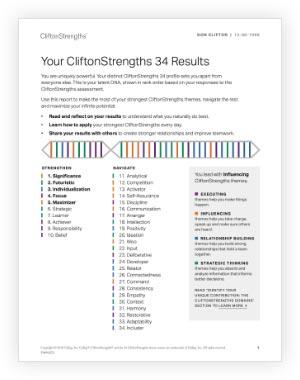Story Highlights
- Focusing on CliftonStrengths and engagement creates sustainable high performance
- To combine the two, focus on five separate areas within your workplace
- The goal is to develop employees who have high performance and wellbeing
Many organizations are very passionate about their employee engagement and strengths-focused efforts, and for good reason. Gallup’s research clearly shows a powerful connection between strengths, engagement and business outcomes. And with an understanding of this impact, clients want to understand more about how to fully integrate a strengths-based approach into the heart of their organization.
Before we discuss these opportunities and how to make them happen, let’s clarify what we are talking about when we bring up strengths and engagement. Gallup’s CliftonStrengths® assessment allows people to thrive by learning about and focusing on their unique talents -- how they contribute in a way that no one else can.
When the assessment is paired with Gallup’s Q12® employee engagement survey, which asks employees about the 12 needs their managers can meet to improve productivity, your organization is equipped to measure whether your employees have what they need to perform at their best using their strengths.
As organizations dedicate their efforts to fully integrating strengths and engagement into their culture, it is important to look at these efforts through five perspectives: individual employees, teams, managers, leaders and organizations. By considering strengths and engagement through these five lenses, organizations can begin to make significant headway on creating a strengths-based and engagement-focused culture that leads to sustainable high performance.
Regardless of which of the five lenses we focus on, the “why” behind the importance of these efforts extends to all. Based on Gallup’s decades of research, it has become clear that focusing on engagement and strengths helps organizations create sustainable high performance by replicating the conditions that already exist in their highest-performing teams. As a starting point, this goal should permeate the efforts across all five lenses. And then the “why” should become more specific as each lens becomes further clarified.
Individual Employees
Successful integration of strengths into an organization starts with the ability to help each employee understand why strengths and engagement matter to them and what they can do to keep these critical elements alive in their day-to-day experiences. For individuals, the “why” lies in (1) being able to develop the best possible version of themselves through their strengths and the work they do each day and (2) experiencing work in such a way that it provides them with intrinsic motivation that enhances their wellbeing both at work and at home.
Employees can bring strengths and engagement to life daily through very clear steps. Strengths come to life in working to understand how your natural patterns of thought, feeling and behavior allow you to succeed every day. Taking time to understand your strengths is at the heart of this. Spending time every day deepening your understanding of who you are, and who you aren’t, is key. This stems from taking time to reflect on how you thought about and navigated the various situations you encountered throughout your day.
This takes effort and commitment. Taking 10 to 15 minutes throughout the day to reflect on your strengths is the key to deepening this understanding. As you reflect, use simple questions to build your self-awareness:
- What went well in a recent conversation, meeting, project or situation?
- How did my strengths contribute to that success?
- What didn’t go well -- where you perhaps struggled to balance the expression of your talents?
- How could I have leveraged my strengths differently to help me succeed?
From an engagement perspective, the key for individuals is considering what aspect of their engagement they can own. Leverage Gallup’s 12 questions to guide your thinking and behaviors around engagement. These 12 items are a highly effective framework for individuals’ needs -- needs that, when met, lead to a stronger sense of being understood, involved, valued and developed. In other words, engaged.
By reviewing these 12 elements frequently, employees can consider where these needs are being met to a high degree and where they aren’t. They can take those areas that are most important to them and keep them strong while also coming up with plans for how to deal with areas that aren’t.
If critical engagement needs are missing, employees shouldn’t wait for them to be met. Instead, they should be proactive and reach out to their managers or peers -- or even get in tune with themselves to work out how these areas can be improved.
Take the “I know what is expected of me at work” item, for example. If this is important to your engagement and you feel unclear about expectations, don’t wait for someone to meet those needs. Instead, be proactive and have a conversation with whoever can contribute to that clarity. This allows for that need to be met and helps you avoid getting stuck and feeling disengaged.
Teams
The great news for teams is that everything covered regarding the steps to take to improve strengths and engagement for individuals also applies to teams. These efforts can be directly supported by and shared within team interactions.
The discoveries each person makes regarding their strengths and engagement should be brought to team meetings and should be openly shared on a consistent basis. Teams should build time to discuss strengths and engagement in their standing meetings at a frequency that makes sense to them.
Setting aside time for these topics reinforces that they matter and puts them in the center of your conversations. By following the steps outlined for individuals and bringing the successes and struggles that result from those discoveries to the team, strengths and engagement become a core part of a team’s ongoing conversations.
These conversations breathe life into critical aspects of your culture. Engagement and strengths drive what we believe and how we operate as a team. Employees will see these discussions as efforts to improve engagement, and that is a very powerful thing.
Gallup’s research shows a strong relationship between employees believing progress is being made on engagement and their actual levels of engagement. For one Gallup client, when employees agreed with the statement, “In the last six months, I have seen my team take action to improve engagement,” they fell into the 98th percentile of engagement. When they strongly disagreed with that item, they fell in the 1st percentile. Having the conversation built into your team meetings, therefore, can create big momentum.
Managers
Seventy percent of a team’s engagement is directly attributable to the manager. Therefore, managers are key to successfully integrating strengths and engagement efforts. This does not mean they do all the work regarding strengths and engagement. Instead, managers encourage, communicate and model engagement and strengths initiatives for their employees and teams.
Managers encourage, communicate and model engagement and strengths initiatives for their employees and teams.
Just like their team members, managers should focus on experiencing the individual benefits of strengths and engagement for themselves and share their experiences as part of team discussions. By building their own understanding of their strengths and engagement side by side with their team members, they are showing that they believe in the power of the approach and that they value this approach to learning about these areas alongside their employees.
Managers often feel they need to have all the answers, but that can lead to burnout. Instead, managers can bring other valuable assets to the table -- namely, their modeling and curiosity. When employees see managers doing what they ask others to do, buy-in and adoption increase. One approach for managers to adopt around strengths and engagement is not to lead with answers but instead to lead with questions.
Example questions include:
- “What did you learn about yourself?”
- “What did you learn about each other?”
- “How will this improve our success as partners and team members?”
Asking employees these simple questions can facilitate better teamwork and show managers' interest in learning about their employees -- not just as workers, but as people. This approach can also equip managers to act more like coaches who emphasize individual wellbeing and make space for each employee to thrive in a way that makes sense for their unique strengths.
When it comes to strengths and engagement, managers need to approach this work as an opportunity for discovery. By encouraging individual and team activities and by being a part of these approaches themselves, managers can easily bring engagement and strengths to life for team members.
Leaders
Leaders play a major role in successfully integrating strengths and engagement efforts into a company’s culture. Of course, leaders should, like managers, encourage, model and communicate about strengths and engagement. These steps are essential for getting true buy-in throughout the organization. But how leaders do this will look different than how it looks for managers.
Managers have the biggest impact at the team level, but leaders can influence more broadly. Although leaders should live out strengths and engagement with their daily teams, they must also broadcast their discoveries and stories more broadly. As we continue to talk about the importance of a “why,” this is often established by leaders who can tie an organization’s strategies to necessary business outcomes.
Leaders must share their insights and support for strengths and engagement in larger forums. Town halls, newsletters or other broad communication approaches are key for leaders to leverage. When team members are experiencing strengths and engagement in their day-to-day activities, that is certainly powerful.
When they then see a leader within the organization talking about their own experiences and recognizing the importance of individual employee engagement, it takes everything to the next level. Not only do they see support from their team, but they also feel supported by their leaders and believe that leadership cares about their wellbeing.
Organizations
The organization itself is the last lens to consider. How are strengths and engagement being supported through organization-wide efforts? Deploying engagement surveys and practices for every employee is a clear example. Ensure every employee has a chance to not only experience the CliftonStrengths assessment but also learn about their results and implement the individual and team approaches covered above.
Beyond these steps, the organization is also responsible for creating other support mechanisms. Providing training on engagement initiatives and providing meetings with strengths coaches are powerful opportunities. Weaving engagement and strengths into every step of the employee life cycle is another.
These steps include attracting talent by telling the world how important engagement and strengths are to your culture, onboarding employees through the lenses of strengths and engagement, and incorporating engagement into ongoing training and development. Simply put, engagement and strengths should be present in every aspect of an employee’s experience.
Sustainable High Performance at Work and in Life
Now that we have explored these five lenses for bringing strengths and engagement to life in your organization, we can’t forget to revisit the “why.” This approach comes down to helping every employee develop into the best possible version of themselves through their strengths and the work they do each day while experiencing work in such a way that it provides them with intrinsic motivation that enhances their wellbeing both at work and in life.
Consider how powerful that is and what this holistic wellbeing does for creating sustainable high performance. “Sustainable” means that it is not just good for the organization but also for each person. Each person flourishes each day and is then able to go home better each night. Organizations focused on strengths and engagement become the places that not only create great jobs but also create a better world -- because your people have the chance to thrive at home, in their work and in their communities. This is a “why” we should all be aspiring to.
Don’t leave employee thriving to chance. Create a workplace built on strengths and engagement:
- Read (and share) a guide on developing your strengths.
- Learn how to improve employee engagement in the workplace.
- Discover how CliftonStrengths for Organizations will revolutionize the development of your workforce.





